
Creating great content, week after week, has a set of challenges.
It’s one thing to understand how to create high quality content, but it’s an entirely different thing to actually do it.
What you’ll quickly find is that if you want to adopt an aggressive content marketing strategy, you’ll need a team to create that content.
And anytime when you have a team working together, things can easily slide into chaos if you’re not careful.
There are basically two ways you can keep a content team working smoothly:
- Good planning
- Using useful tools
Both are important. Even with the best tools in the world, you won’t get anywhere if you don’t plan well.
But I’m going to assume that you have at least a decent grasp of how to manage your team and content strategy.
Instead, I want to focus on the second main point – tools.
I’m going to share with you 15 tools that can help you create better content as a team, while minimizing the chance of mistakes.
You definitely won’t need all of them, but you’ll probably want to use at least one from each of the four main classes of tools.
An organized project is an executed one (Project Management)
You need to keep things straight.
When you are planning content for months ahead, you’ll have writers working on it and turning it in at all sorts of times.
On top of that, you’ll have to communicate to edit content and, possibly, your promotional plan as well.
Needless to say, this can get messy fast.
You can lose track of certain pieces of content, emails, files, etc.
Luckily, there are tools that will help you plan your strategy and also keep track of your progress.
1. Trello: When it comes to any conversation on project management, Trello is always one of the first tools mentioned.
It’s very versatile.
It’s a great tool to increase productivity that can be used for both personal and team projects.
The concept is extremely simple.
First, you create a “board” in Trello:
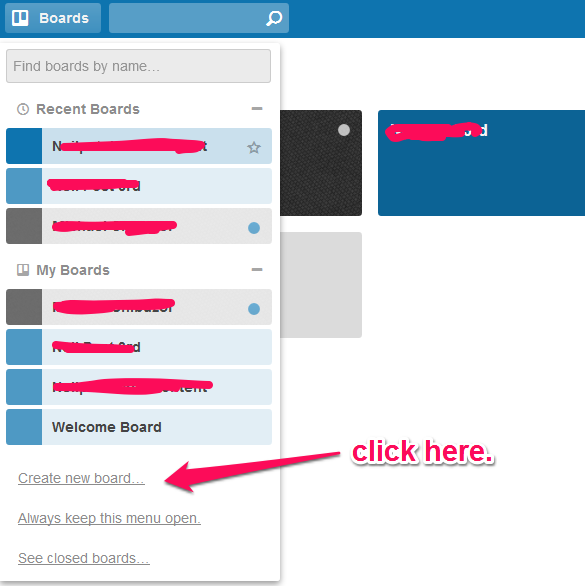
Basically, you want to have a board for each project you have on the go.
You can have as many as you need—there are no limits.
On each board, you can add lists for each main category of tasks.
Finally, you can add cards (to represent tasks) to each of the lists:
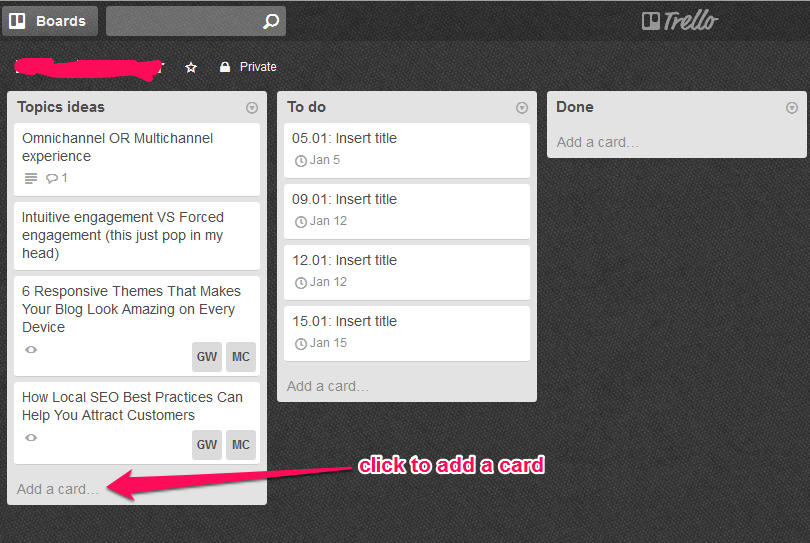
The visual overview of all your tasks is really handy.
In addition, the tool has a few really neat features:
- drag and drop your task cards from list to list
- set due dates for each individual card
- comment on or attach files to each card
Additionally, you can also add members to each board.
These members can interact with your cards and lists and even add their own.
This makes Trello an incredibly useful collaboration tool.
To add someone to a board, just click on “add members” from the menu once you’re inside the board you want.

Once you’ve added a member to a particular board, you can then click on any of your cards and add a member to it.
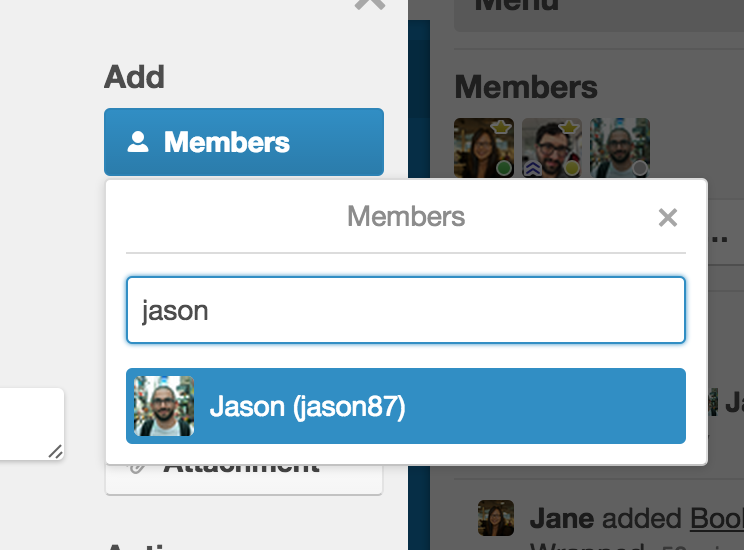
They will get a notification in Trello and possibly an email (depending on their settings).
An alternative to Trello is Kanbanchi.
It works in a very similar way, but it’s perhaps a bit simpler and can also be color coded.

Just like in Trello, you can assign particular tasks to a specific person on your team. They will get a notification that they are expected to complete the task.
There’s nothing wrong with either, pick one that you like the feel of.
2. Streak CRM for Gmail: This tool is a CRM (customer relationship management) plugin for Gmail.
Obviously, CRM tools are different from content creation tools.
However, I feel that there are a few useful features of the tool that will help you create better content.
First of all, this is what it looks like:
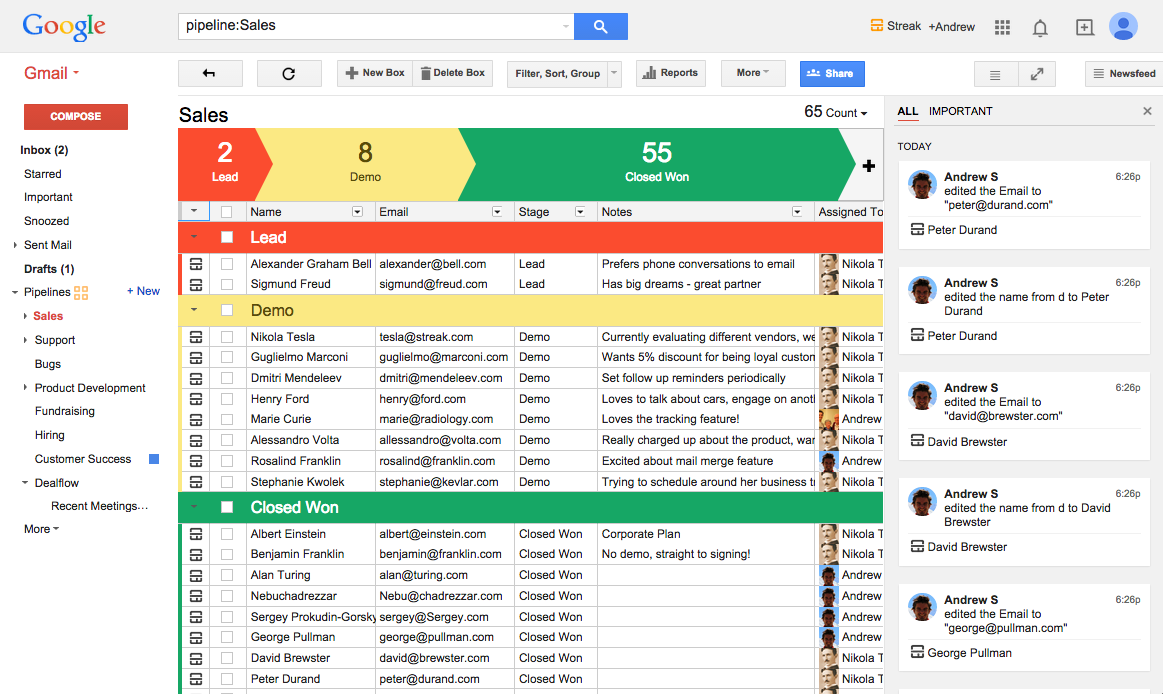
Streak is a simple, yet useful, panel in Gmail itself. You navigate it using the left side menu—the same one you use to navigate through your different email boxes.
The two main areas of the tool are sales and support dashboards.
It’s set up so that you can assign members of your team to specific contacts that you’ve entered in either of the main areas:

There are two main areas where the tool could help you with content creation and promotion.
First, you can highlight any support questions that would make good content ideas. You could even assign someone to the task using the tool.
Secondly, you can use the tool to see where prospects are in your sales funnel.
When they reach different parts of the funnel, you should send them content that will improve your conversion rate. Content such as case studies usually works best.
3. Basecamp: Trello is a great project management tool for small to medium projects, but it doesn’t quite work when you have many projects, people, and parts of the business that need attention.
Basecamp is one of the leading all-in-one solutions.
First, you can add all members of your team to a project. That way, they can see every message and file and can interact in comments or the calendar:

The calendar list is pretty much what you’d expect, and it’s very useful:

Even though Trello also has due dates for tasks, it’s often hard to display them all at once.
On large projects, you’ll have too many notifications to keep up with. With Basecamp, you have the option of viewing the calendar, which gives you a bird’s-eye view of all the tasks in a project.
I won’t go into every single feature of Basecamp, but it has an impressive set of features.
You can have discussions, create to-do lists, and upload files as well.

There’s a bit of a learning curve initially, but after that, it’ll become a very simple, yet effective tool for you to use.
There’s no reason why you can’t use it to manage your content creation.
4. MindMeister: When you’re trying to figure out your content plan, it’s often helpful to visualize how all of the pieces fit together.
A great way to do that is with a mind map.
This tool is one of many mind map tools but very simple to use.
You can click on any node and then press the “tab” button to create a child node.
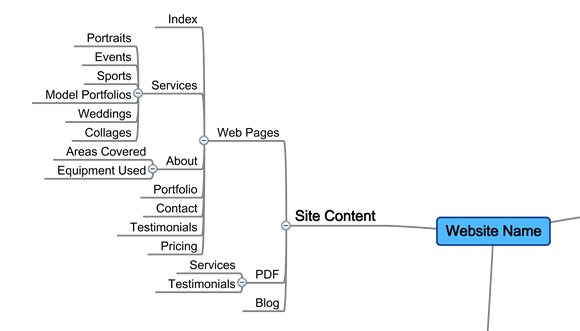
Notice the little minus signs at each child node. You can click these to hide or expand each section.
This is a great tool to use whether you’re planning out your overall content strategy or a really complex piece of content.
For example, if you created something like an advanced guide to SEO, you could create a node for each of the main sections and then create branches for each of the subheadings in those sections.
5. A web whiteboard: I’m sure you’ve had some sort of meeting before in your life. Although meetings are usually a waste of time, the one really useful tool they typically utilize is the whiteboard.
It allows you to collaborate with other people and easily combine images and text to get across complex points quickly.
Online collaboration, which is more and more common these days, means you can’t use a whiteboard any more.
Or does it?
This tool is an online whiteboard.

You can do the same things here as you can on a normal whiteboard.
In fact, you can do even more because you can paste images on the board as well as write on it.

You can add however many people to the board you need, and they can edit it as they see fit.
I think this could be a useful tool if you’re already on a call with other members of your team.
If you ever want to see examples of useful whiteboards, just check out any of Moz’s whiteboard Fridays.

Say goodbye to endless copies of files (Content Creation)
Every business’ content creation process looks different.
It depends on your team and the way you like to work.
At some point, however, you will have at least a few people working on each piece of content.
You’ll have one or more authors as well as one or more editors to help fine-tune each piece of content.
If you still attach a new file every time you make a change to the content, I feel for you.
Doing that is confusing enough for a single article, but doing that for several on the go is near impossible.
You’ll waste a ton of time looking for particular files and end up making mistakes anyways.
Thankfully, it’s 2015, and there are many better alternatives. Here are some of the ones I’ve found most useful.
6. Google Docs: Many content creators are hesitant to give Google Docs a try because they used it a few times years ago and weren’t impressed.
But it’s come a long way since then.
While Microsoft Word might be better in a few ways, Google Docs holds its own.
It has all the essential formatting options you’re used to, but there’s one huge benefit…
Multiple people can view a document at one time.
They can make edits, they can comment, and you can even chat with them inside the window.

When you create a document, you have a few different ways to share it. You can see these by clicking the “Share” button on the top right.

Your first option is to simply invite people to the document using their email addresses. Using the drop-down menu, you can choose what permissions they get (read or edit):

Or you can get a link to share. Again, you can set the permissions so that anyone you send the link to can either only read or edit as well.
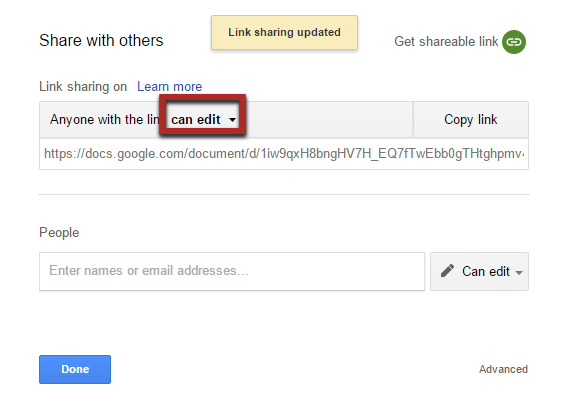
The only difference between the two is that if you share the file using the first method, those people can go into their Google Docs accounts and find the file again. Anyone with just the link will need to remember the link if they want to return to the file in the future.
The final thing I want to mention about Google Docs is that it isn’t just limited to writing.
You can share Google spreadsheets or slideshows in the same way.
7. Red Pen: This tool is specifically designed to help you edit as a team.
It’s primarily a tool for visual content, but there’s no reason why you couldn’t take a screenshot of written content if you wanted to edit that.
It works by you uploading an image to the tool.
Then, you can make editing notes on it by clicking somewhere on the image and typing your comment.

The comments can be expanded or hidden by clicking them.
The most important feature, assuming that you’re working as a team, is that you can add multiple people to the project.

Their names will be attached to any comments made on the image.
8. GoVisually: If you’re looking for a slightly more advanced editing tool for visual content, this may be the best option for you.
Again, you upload images into project folders within the tool. You can also add whomever you like to a project by sending them an email invite from the right sidebar of the tool:

There are a few neat features you’ll find useful when it comes to collaborating on editing an image.
First, you can make comments on any part of the image. However, you start a comment thread when you do.
This means that other people in the group can reply to that comment until the issue is sorted out.
Instead of having a ton of unorganized comments, you have them all organized by the original comment.
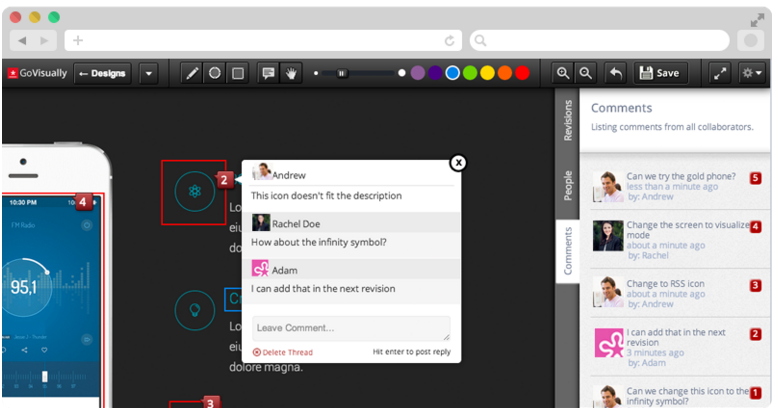
As you can see from the screenshot, you have a ton of annotation options. You can add shapes and use different colors.
Finally, there’s a useful Revisions feature of the tool. You can continue on the same project and create a new revision for it that is linked to the previous ones.
You can navigate between them using the revisions tab on the right sidebar. This avoids the problem of having too many comments on a single revision and having to keep track of what was done at what time.
9. SamePage: This tool is ideal when you have content that has a high degree of complexity.
And by that I mean that extensive research needs to be done and many people need to come together to create it.
SamePage, as the name gives away, allows you to keep all your project information on a single page:

It has several project management features, like being able to create a visual project timeline.
You can upload files and access them using the left sidebar.
You can invite as many people to the group as you like. And anyone can comment on any page in the project.
This could be used as a tool to keep your overall content strategy on track. But it can also be used to create a new project for each piece of complex content.
If you know a piece of content is going to take months to assemble, you can create a timeline for all the different parts:
- data collection
- data analysis
- other research
- critiquing research
- content creation
- editing
- publishing
That’s overkill for many posts, but if you’re creating something like an advanced guide, it could be really useful for staying on track.
How to ensure you’re always on the same page (Communication)
One of the most challenging aspects of working in any team environment is communication.
Good, open lines of communication allow you to produce better content (or results in general) and avoid last minute emergencies.
You don’t want to find out the day before a post goes live that the writer has had a problem. Especially if it’s an issue that you could have fixed as soon as you heard about it.
I bet you understand that communication is important.
However, it’s possible that you’re not using the best tools for the job.
I know that many marketers, writers, and business owners only use email to communicate.
That can work well if you have a small team. But if you’re collaborating on content with multiple team members, email gets messy quickly.
You’ll lose track of past messages, occasionally forget to include someone in an email chain, and then have a huge pile of emails sitting in your inbox that you can’t get rid of.
It’s not ideal.
Hopefully, one or more of the tools in this section will meet your needs.
10. Slack: This tool was launched by the co-founder of the massive photo-sharing site Flickr.
To say that it’s exploded in its growth is an understatement.

If you haven’t heard of it until now, you’ll start hearing about it increasingly more in the future.
It’s a tool designed to improve group communication and collaboration.
Just like most other messaging tools, it works both in a browser and as an app on any mobile device.

When you create a group, you can create different hashtags (e.g., #research for a chat about content research) to represent different conversations.
It has a beautiful layout, and members will get notifications beside each conversation when new messages appear.
You can also attach and comment on files.
Once you’ve set up a project, you can create a channel, then right-click it and invite people to join:

These are private chats, so no one will be able to see them unless you give them permission.
This kind of a chat tool is best when you need to consistently be in contact with your team multiple times a week.
It’s especially useful if you need to have group conversations where everyone needs to be able to contribute.
11. Skype: No, Skype is not exactly new or unpopular, but it’s always a good option that should be considered.
Slack is a tool best used by groups that need to communicate with each other.
But what about situations where you’re working with a bunch of employees or freelancers on a one-on-one basis?
That’s when a tool like Skype is a great option.
You can add as many contacts as you need, and the best part is that most people already have Skype accounts and know how it works.

On top of that, you can also create group chats when needed; I just find them not to be quite as organized and user-friendly as a tool like Slack makes them.
The big feature of Skype is that you can quickly jump on a call (or video call) with any of your contacts.

Some topics are too complex to talk about efficiently in an email. It’s often easier to jump on a call for 5 minutes and sort things out instead of spending hours sending emails back and forth.
12. Google Hangouts: An alternative to Skype is Google Hangouts. It has the added benefit of working in a web browser.
In many ways, it’s similar to Skype, but there are a few important differences, which may make it better for your content creation team.
First, the group video calls are better. The connection is usually solid, and you can click on anyone’s screen in the video (along the bottom) to make it bigger.

In addition, it’s also very easy to get people on Google Hangouts even if they haven’t used it before.
Why? Because you can use people’s Gmail addresses to invite them, and most people will have those.
Just like with Skype, you always have the option to chat, whether in the browser or the mobile app:

Overall, it’s developed into a really good communication tool, so if you’re a fan of Google products, give it a try.

If there’s one specific situation where it excels, it’s running the group video chats. This is a perfect replacement to in-person meetings if you’d still like to hold them.
Never lose track of a file again (Sharing files and information tools)
The one final problem you might encounter when running team projects is file management.
Part of any good content creation process is improving the first draft.
No matter how good of a writer you are, the first draft will require further improvement.
So, you bring on an editor to help you out.
But as your team grows and you produce more and more content, it’ll be hard to keep things straight.
You end up with several revisions of files that are scattered all over the place.
The solution is to have one central storage location for content files that anyone on your team can access.
These tools can help you do that.
13. Dropbox: This tool was really the first to capitalize on the shift to cloud storage.
While everyone else was focused on storing backups on external hard drives (and even CDs), the team at Dropbox created a tool that allowed you to back up your files and access them anywhere.
And if you don’t have many, it’s free. If you do, it only costs a few dollars a month.
You can configure your Dropbox account to automatically sync with your PC.
So, when you change a file in any way, you just have to give it a second to sync with your web account. Then, anyone on your team with access to the file will see the updated version.
With this feature, you’ll no longer have “Content_v_5.6” and so on floating around and confusing everyone.
Which brings us to the second main feature: sharing.
You can either share individual files or whole folders.
The advantage of sharing a folder with your content creation team is that you only have to do it once, and then they have access to anything you put in that folder.
You can give them access either from your online Dropbox account or from your local computer.
Just right-click the folder, and choose “Share this folder”:

If you’d rather do it online, navigate to the folder in your dashboard (or click the blue “New shared folder” button:

Finally, you can click on any individual file as well, click “get link,” and get a link that you can share with anyone you wish.

The only thing you really have to be careful about is editing a file at the same time. This will result in duplicate copies of the file.
It’s pretty easy to avoid though as the file will show a label telling you that it’s being used.
14. Google Drive: After the success of Dropbox, many companies launched their own cloud storage businesses.
Google Drive has become one of the industry leaders.
Since it’s a Google product, it has one advantage no one else can offer. It works automatically with your Google account, and you can share files with people based on their Google accounts.
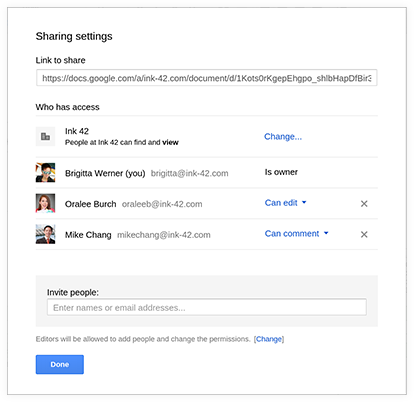
You share files just like in Dropbox.
Simply click the drop-down menu next to a folder on Google Drive, and click “Share”:

In case you were wondering, you can also configure Google Drive to work on your local computer. You can set up a folder that looks like any other folder on your computer that automatically syncs with the files in your online account.
One final part of Google Drive that I should mention is that it integrates perfectly with Google Docs.
If you use Google Docs, this is the obvious file sharing and storage tool for you.
Google Docs will automatically save your files in your main Google Drive folder. You can drag them to a shared folder after if you want.
15. SharePoint: There’s one final main option that works well when you need to edit a lot of files as a team.
SharePoint is a Microsoft product and looks like it, which makes it easy for most people to get used to it quickly.
Like with the other options, you can upload any files you’d like here and organize them by folders:

You can set SharePoint to lock a file while it’s being edited, which eliminates any duplication issues you might get with Dropbox.
In addition, there are sharing settings just like with the other options.
And while Hotmail may not be as popular as Gmail, many people still have an account that you can invite them with.

To share a folder or file, you click the file, click the “Share” button in the top right, and then enter your recipients’ names or email addresses in the box.
You can give them different access rights (e.g., just reading or editing too).
Finally, you also have the option of sharing a file through a link:

Overall, it’s a very similar option to either Dropbox or Google Drive.
Other than the particular case I went over with Google Drive, all these options are top quality and will work for most teams.
Go with whichever you like the most, but don’t stress over choosing one. They all have similar feature sets and are fully developed at this point.
Conclusion
You can create all your own content if you make it your top priority.
However, not everyone wants to do that.
So, when you get to the point of creating a ton of content, you’ll probably need help.
But if you use the same process you were using before, you’ll run into problems.
You need to have the right tools to effectively manage a content creation team. Otherwise, you’ll end up wasting time and money and be stressed all the time.
I’ve shown you 15 different tools that can help improve your collaboration process.
No one needs to use them all. However, you’ll probably want to choose at least one from each of the four categories.
from Quick Sprout https://ift.tt/2uC47rD
via IFTTT
